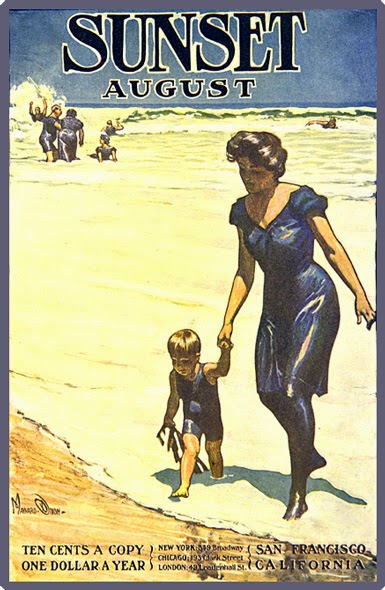 |
| Maynard Dixon, Sunset magazine, cover illustration |
Born in Fresno CA, Dixon was descended from a prominent Confederate family from Virginia. He may have been related to the British surveyor Jeremiah Dixon, whose name is one half of the boundary that divides North from South, the so-called Mason-Dixon Line. It is also sometimes claimed that the nickname "Dixie" for the South was derived from the same family name. Whatever, Maynard Dixon is not typically linked with the South, but with the Southwest and West, especially New Mexico and California.
For the moment, we haven't found any evidence that Dixon was a camouflage artist. But we have found indications that some of his artist-friends were camoufleurs in San Francisco during World War I, and that in 1917 he was among the founding members of the American Camouflage Western Division in San Francisco. Although he apparently did not design camouflage, his awareness of the practice can be assumed by the fact that among his associates were Santa Fe-area artists William Penhallow Henderson (1877-1943) and (Swedish-born) Bror Jullius Olsson Nordfeldt (1878-1955), both of whom were ship camoufleurs in San Francisco. For more information on Maynard Dixon, see Donald J. Hagerty's The Life of Maynard Dixon (Smith Gibbs, 2010).
 |
| Cover of The Life of Maynard Dixon (2010) |
The American Camouflage Western Division was a spin-off of the New York-based American Camouflage group (aka the New York Camouflage Corps), founded by Barry Faulkner and Sherry Fry. The purpose of the Western branch, whose designated founder was A. Sheldon Pennoyer, was the recruitment of "painters, sculptors, scene painters, house painters and all others interested in the application of protective coloration and devices for the deception of enemies and the rendering invisible of our own forces." That text excerpt appeared in the August 1917 issue of Western Architect and Engineer, in an article titled "San Francisco Architects and Artists as Camoufleurs" (p. 58), as did a roster of those who had by that time joined the Western camouflage unit, among them Maynard Dixon. Here's the list—
Chairman: Mr. Arthur Brown, architect. Assistant Chairman: Mr. Bruce Nelson, artist. Secretary: Mr. A. Sheldon Pennoyer, artist. Executive Members: Mr. John I. Walter, president, San Francisco Art Association; Mr. Edgar Walter, sculptor; Mr. E.S. Williams, scene painter Alcazar theatre; Mr. Ralph Nieblas, scene painter Columbia theatre; Mr. Warren C. Perry, instructor in architecture, University of California; Mr. Maynard Dixon, artist; Mr. Lee [Fritz] Randolph, director California School of Fine Arts.
In addition there is mention of experiments in ship camouflage, of which it is said "that the results obtained by the use of several colors in small squares, maplike patches, serpentine lines and similar methods have rendered our ships more invisible than those of any other navy treated in this manner."
In the January 18, 1919, issue of the El Palacio (Journal of the Museum of New Mexico), there is the following note about "Talk on Ship Camouflage"—
William Penhallow Henderson, the Santa Fe artist, who was a camoufleur on the Pacific Coast, one of the three in charge of the camouflage work in the western ship yards, gave an illustrated and instructive talk on Ship Camouflage on Museum Night, January 7. Besides blackboard drawings, a model of a camouflaged ship made by O.T. [sic] Nordfeldt, was used to illustrate the lecture.











